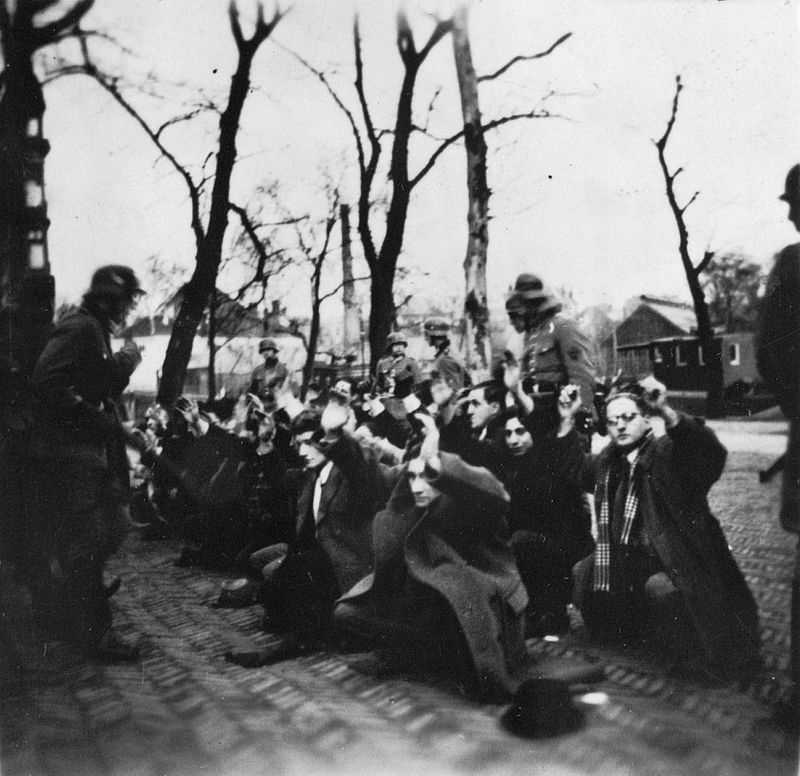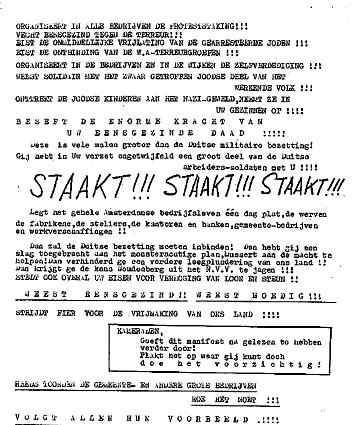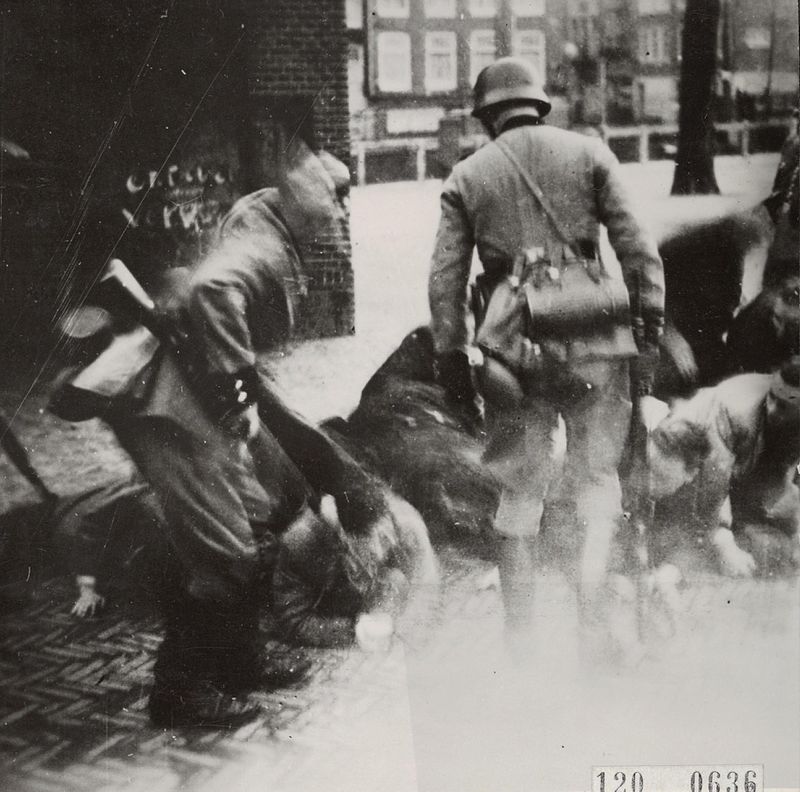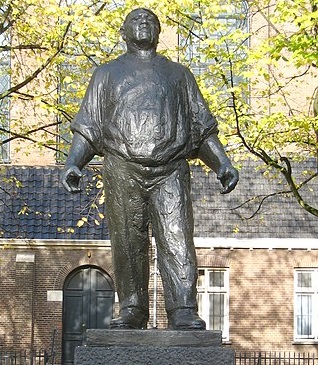This year, on 25 February, it’s exactly 80 years ago that the February Strike took place in the Netherlands. This is without a doubt one of the most heroic events in Dutch history. The February strike is considered to be the first general strike that served as a public protest against the Nazis in occupied Europe, and the only mass protest against the deportation of Jews to be organised on a class basis.
The strike started in Amsterdam and spread to many other Dutch towns. Total estimates are that about 300,000 people joined the strike. It was one of the key moments in the history of class struggle in the Netherlands.
Wartime occupation
The Netherlands surrendered to Nazi Germany in May 1940. The Dutch ruling class was not prepared to resist Germany. Its land army was very outdated. Dutch imperialism mostly relied on the exploitation of Indonesia with help of the navy, while it pursued a policy of “neutrality” on the European continent, balancing between Britain and Germany. After Hitler came to power in 1933, he was seen as a 'friendly head of state'. Jewish, socialist and communist refugees from Nazi Germany were regularly sent back or detained. As late as February 1940, revolutionary-socialist leader Ab Menist was in jail for two weeks for “insulting the friendly head of state Hitler”.
This didn’t matter in the end, as the imperialist contradictions between Germany and Britain led to war, where Germany needed control over the North Sea coast. This meant invading the Netherlands, which Germany managed to realise with all kinds of atrocities, such as the bombing of Rotterdam.
To get the Dutch population to the side of Nazi Germany, the occupiers tried to pursue a policy of divide and rule. The Dutch were branded as ‘Aryan people’, similar to the Germans, while the Jews were considered to be a lesser ‘nomadic people’. It has to be stated that anti-semitism was already existent before in Dutch society, and was rising in the 1930s as reactionary forces tried to turn the local population against German Jewish refugees. However, the Nazis elevated this to a higher level. Jews were fired from public positions, barred from government jobs and had to register themselves as being Jews.
The NSB
The NSB (the Dutch National Socialist Movement) was used to aid the Nazis. This fascist organisation had a reasonable basis in the 1930s, but was not nearly as strong as the NSDAP in Germany in the years before the seizure of power. In fact, the membership decreased in the last few years before the occupation of the Netherlands. With the support of the occupying force, the NSB regained renewed confidence and its street fighting arm, the WA (Weerbaarheidsafdeling - ‘Resilience Department’) began intimidating actions against Jews and leftwing political opponents.
 Persecution of Dutch Jews provoked a backlash from the masses / Image: Nationaal Archief
Persecution of Dutch Jews provoked a backlash from the masses / Image: Nationaal Archief
Various anti-Jewish actions were carried out by the WA in the big cities. Attacks took place on Jewish shops, on cafés that refused to display a sign saying “forbidden for Jews”, etc. While there was anti-semitism present in the Netherlands, there also existed a socialist-communist tradition of solidarity. Several leaders of the Social-Democratic Labour party (SDAP), the predecessor of the Labour Party, and the Communist Party of the Netherlands (CPN) were Jewish. This tradition manifested itself in spontaneous expressions of solidarity with the Jewish population among the non-Jewish working class. For example, after attacks were committed by the WA on Jewish shops in the Schilderswijk neighbourhood of The Hague, the local working class took to the streets to avenge this with counter-attacks on shops owned by NSB-members.
This eventually culminated in a series of street battles between the WA on one side, and Jewish self-defence groups and their non-Jewish supporters on the other side, culminating in a pitched battle on 11 February 1941 on Amsterdam’s Waterloo Square, in which prominent WA member Hendrik Koot was badly wounded. He died of his injuries three days later. This was the signal for extra repression by the German occupying forces. The Jewish neighbourhood was closed off as result.
A week later, the Grüne Polizei (the German police force) invaded an ice cream shop in Amsterdam South, which was run by two German Jews, because a Jewish self-defence squad used this as a meeting place. In the fight that ensued, several police officers were wounded. Revenge for this and other fights came on the weekend of 22–23 February, when a large scale pogrom was undertaken by the Germans.
On the Jonas Daniël Meijerplein, with the help of the Sicherheitsdienst (German state intelligence agency), 427 Jewish men were brought together in a violent manner to be taken away, and were publicly humiliated. The majority of them would eventually perish in the Mauthausen concentration camp in Austria. Because it was a market and there were also many non-Jewish people present, this caused a major shock among the Amsterdam working class.
The strike is called
While the fascist occupation regime was completely opposed to any strikes, the February strike was not the first strike during the occupation. In different places, there had already been some strike actions by unemployed workers in forced work programs, against the extension of the workday or for higher unemployment grants. Next to that, there were stirrings at the ship wharfs in Amsterdam North, when it was announced that some workers would be picked by random selection in order to work in Germany. This led to a strike on 17 February. The CPN was preparing to convert this anger into a general strike, but the German occupiers cancelled these plans, so the planned strike for the 18th was called off.
 The February Strike was certainly one of the most heroic chapters in the history of the Netherlands / Image: public domain
The February Strike was certainly one of the most heroic chapters in the history of the Netherlands / Image: public domain
However, the fighting mood was still there and was galvanised by the anti-Jewish events on 22-23 February. The next day, 24 February, the CPN held an open-air meeting at the Noordermarkt to discuss a general strike, at which many rank-and-file members working for the municipality of Amsterdam were present. It was decided that the municipal workers would strike the following day, followed by a general strike on the 26th. That same night the pamphlet with the famous words “STRIKE, STRIKE STRIKE !!!” was printed, which was distributed the following day by the cadres of the party to the workers.
On the 25th the tram drivers stopped working in the morning, followed by the other municipal services later in the day. CPN militants went to the wharfs to get the ship-builders to join the strike, and the ship-builders went along to the centre to help spread the strike to other municipal workers.
On the 26th, the strike spread further, especially to the private sector. Female workers played a major role in spreading the strike to sewing workshops. Even school students refused to go to lessons and walked out of the school. The strike was not limited to Amsterdam: it spread to about other towns and regions: Haarlem, Velsen, the Zaanstreek, Weesp, Bussum, Muiden, Hilversum and Utrecht.
After the surprise effect was over, the repression already started on the 25th in the afternoon. The fascist regime used gunfire to end the strike, which led to nine deaths and 24 seriously injured. The repression was initially mainly carried out by the Grüne Polizei, because the ordinary German soldiers were less trusted with committing such large-scale repression against the civilian population.
Although the strike was unable to stop further deportations, it came as a big blow to the Nazis. The divide and rule policy of setting up the “Germanic Dutch” versus the Jews had not worked, given the great solidarity of the Dutch workers with the Jewish population during the February strike. This meant that the occupation had to be carried out with more repression, and the true nature of the fascist regime became clear to many. Thus, the first executions of communist militants took place in March. In addition, hundreds of communists were arrested in the months following the strike.
The appropriation of the strike
The February strike was the result of working-class solidarity in Amsterdam and other towns, with the Jewish population. The most important role was played by the rank-and-file members of the CPN. A smaller role was played by the Marx-Lenin-Luxemburg Front, the underground continuation of the Revolutionary Socialist Workers’ Party led by Henk Sneevliet (who collaborated with the Fourth International for a couple of years). Next to that, many other socialist and non-party workers mobilised for the strike. It was the last general strike that took place in the Netherlands, and it was the only general strike against the deportation of the Jewish population during the Second World War. It was a clear example of anti-racist resistance on a class basis.
After the war, however, the Dutch ruling class appropriated this strike as an act of “national resistance” by the Dutch people. Many times the Dutch queen or king spoke at the commemorations. The role of the CPN was obscured during the Cold War and their members were not even allowed to attend the commemoration until 1968.
However, the role of the Dutch ruling class, the Royal Family and the government that went into exile in London, was extremely negative for the Jews. The ruling class was mainly concerned with safeguarding its own interests. Part of the Dutch ruling class wanted to submit to the occupying forces. After all, their capital was not threatened, only subject to German war interests. Another part saw more salvation in cooperation with the Allies and a third part was undecided and wanted to opportunistically follow whoever was winning the war. After their flight to England, the Royal Family and the government in exile initially entered into secret negotiations with the Germans, but eventually, they opted for the Allied side. From England an attempt was made to get a grip on the majority of the Dutch resistance fighters, to bring them in line with the interests of the Allies.
Preventing the persecution of the Jews was never their goal however. The chief inspector of the Dutch Railways was a member of the bourgeois resistance, who was in contact with the government in exile and had asked several times what should be done about the deportation of Jews by trains to Germany. The answer from London was “Nothing! Continue!“, because a railway strike would be bad for the economy (read: the interests of Dutch capitalists).
From this it is clear that the ruling class mostly did nothing to stop the deportation of the Jews, while the working class risked their lives in a dangerous strike. We should never forget this part of history and protect it against all white-washing in the name of ‘national unity’, with commemorations attended by the King, etc.
After the strike
After the February strike, the fascist occupying forces increased their repression. The divide and rule game had not worked sufficiently, as the united struggle from below had shown. The true nature of fascism was revealed, and the support for the Nazis under the Dutch population dropped further.
 After the strike, Nazi repression intensified, showing the true face of fascism / Image: Nationaal Archief
After the strike, Nazi repression intensified, showing the true face of fascism / Image: Nationaal Archief
The CPN had played a fundamental role in the strike, mostly because of the pressure of the rank and file. This was in spite of the incorrect course pursued by the Stalinist leadership. Since the Stalin-Hitler Pact of 1939, Moscow imposed the line that Britain and the Allies were the main evil, instead of focusing on both imperialist camps. However, as the party was illegalised, on an empirical basis the party started underground work and started to resist the anti-Jewish measures (some of the most important party leaders were Jewish themselves). The February strike increased the role of the party in the resistance, and increased the repressions against the party.
When Hitler invaded the USSR, the party line was changed from the top. It was now imperative to fight Nazi Germany to the end. This had to take place through an Anti-Fascist People’s Front policy, where the communists had to ally themselves with all other ‘anti-fascist’ forces, including the Allies. This was no independent class policy, but de facto support for one of the imperialist camps and a part of the capitalist class. This policy reflected the interests of the Soviet bureaucracy. In the concrete Dutch situation, it meant collaboration with bourgeois resistance organisations in the Council of Resistance.
Of course, this mistaken policy of the leadership does not in the least diminish the heroism of the resistance acts by the CPN militants. The CPN’s popularity rose during the war years, which became clear after the liberation of the Netherlands by Allied forces. During and after the defeat of the Nazis, there was a revolutionary wave going through Western Europe. However, the Stalinist leadership of the Communist Parties channelled this into ‘governments of national unity’, where Communist Parties took minister posts in Italy, France, Belgium and even Luxemburg. In the Netherlands, almost the same took place in 1946. The communist paper De Waarheid was the biggest newspaper in the Netherlands. The CPN won the Amsterdam municipal elections of 1946 and joined the local government. Party leader Paul de Groot was discussing entry into a national unity government, but negotiations broke down over the number of CPN ministers.
The CPs were thus used to lead the revolutionary initiative of the masses into safe channels, leading to a ‘counter-revolution in democratic form’. Through this betrayal and the subsequent Marshall Aid, capitalism was saved in Western Europe. The Fourth International. founded by Leon Trotsky in 1938, was too small to play a leading role. This meant the revolutionary momentum was lost and would not reappear in Western Europe until the late 1960s.
Legacy
The February strike is one of the key moments of Dutch class struggle and should be commemorated for that reason. We should save the legacy of this general strike, from the claws of the ruling class and its message of ‘national unity’.
Together with smaller solidarity actions, it shows how racism and fascism can and should be countered by actions on a class basis. The tactic of divide and rule was cut across by working-class solidarity with the Jewish populations. While of course the situation nowadays is totally different, we have seen a rise of rightwing demagogic parties and increased aggression by small fascist groups in Europe. Let the February strike be a reminder for the workers’ movement that it is their task to unite workers and unemployed of all ethnicities against racism, and that it is actually possible to unite on a class basis.

